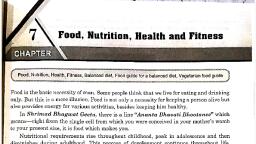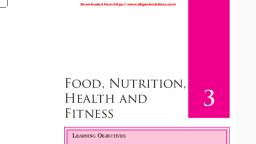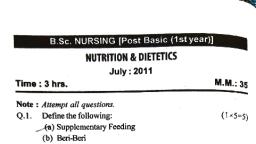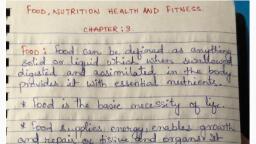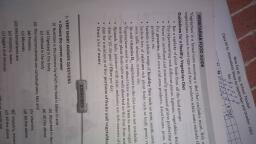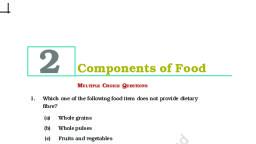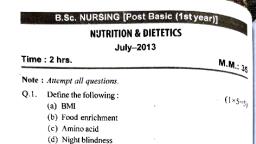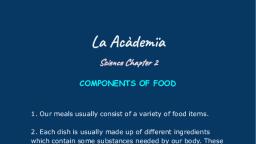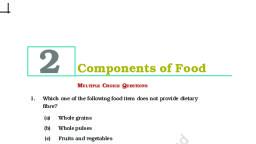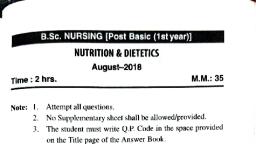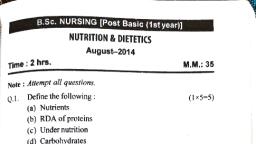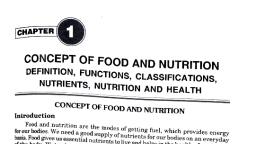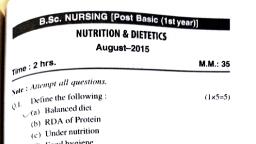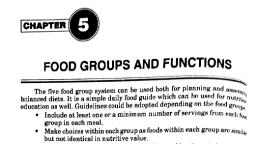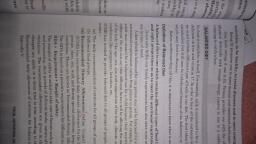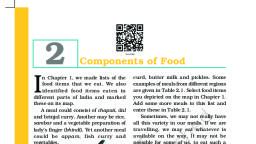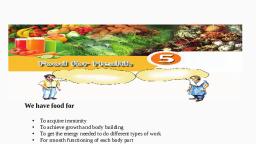Page 1 :
UNIT- II-D, (PART-II), FOOD, NUTRITION, HEALTH AND FITNESS, Balanced Diet:, A balanced diet is one which includes a variety of foods in adequate amounts and correct proportions, to meet the day’s requirements of all essential nutrients such as proteins, carbohydrates, fats, vitamins,, minerals, water and fibre., OR, A balanced diet is one which contains different types of food in adequate quantity and right, proportion so as to meet the nutritional requirements of our body., A diet which is balanced for one person may not be balanced for another one because the nutritional, requirement varies from person to person., For example, a balanced diet for an adult man cannot be balanced one for a child because their nutritional, requirements are different., So ICMR (Indian Council Medical Research) has worked to provide balanced diet to all groups of, people through RDAs (Recommended Dietary Allowances)., , Recommended Dietary Allowances = Requirements + Margin of Safety, Recommended Dietary Allowance (RDA):, Average daily level of intake is sufficient to meet the nutrient requirements of nearly all (97% –, 98%) healthy people., Thus, a balanced diet takes care of the following aspects:i) Includes a variety of food items., ii) Meets the RDA for all nutrients., iii) Includes nutrients in correct proportions., iv) Provides a safety margin for nutrients., v) Promotes and preserves good health., vi) Maintains acceptable body weight for height., , Why we should choose Balanced diet:, 1) It includes variety of food items., 2) Meets the RDA for all nutrients., 3) Includes nutrients in correct proportions., 4) Provides a safety margin for nutrients., 5) Promotes and preserves good health., 6) Maintains acceptable body weight for height., , Using Basic Food Groups for Planning Balance Diets:, Different foods have varied amount of nutrients. Hence, we required different food products for a, balanced diet.
Page 2 :
One of the simplest ways to plan a balanced diet is to divide foods into group is included in the, meals., Various organizations have framed different schemes of food groups so according to Indian, conditions,, ICMR has recommended Five Food Groups for meal planning., This classification is done based on many factors like availability of food, cost, meal pattern etc., This classification includes:i) Cereals, grains and products, ii) Pulses and legumes, iii) Milk and meat products, iv) Fruits and vegetables, v) Fats and sugars.
Page 4 :
A note to remember:, 1 (One) gram of carbohydrate gives 4 kcal of energy., 1 (One) gram of protein gives 4 kcal of energy., 1 (One) gram of fat gives 9 kcal of energy., , Guidelines for using the basic food groups:, , , , , , , , , , , Include at least one or a minimum number of servings from each food group in each meal., Make choices within each group as foods within each group are similar but not identical in, nutritive value., If the meal is vegetarian, use suitable combinations to improve the overall protein quality of the, diet., Include uncooked vegetables and fruits in the meals., Include at least one serving of milk to ensure a supply of calcium and other nutrients., Cereals should not supply more than 75% of total calories., Carbohydrates like sugar and jiggery should not contribute more than 5% of energy., Fats should not contribute more than 15% of total energy., Proportion of cereals and pulses in food should be between 4: 1 or 5: 1, , Food Guide for a balanced Diet:, Food Guide Pyramid:
Page 5 :
The food guide pyramid is a graphic depiction of the daily food guide., The size of each section represents the number of daily servings recommended., The broad base at the bottom conveys the message that grains should be abundant and form the, foundation of a healthy diet., Fruits and vegetables appear at the next level, showing that they have a less prominent but still, important place in the diet., The next level comes for pulses and legumes. It shows the moderation consumption of these foods in, the diet., Meals, milk and products appear in a smaller band near the top. A few servings of each can, contribute valuable nutrients such as proteins, vitamins and minerals without too much fat and, cholesterol., Fats, oils and sweets occupy the tiny apex, indicating that they should be used sparingly., Alcoholic beverages do not appear in the pyramid but they too if consumed should be in limited, amount., Items such as spices, coffee, tea and diet soft drinks provide few nutrients but can add flavor and, pleasure to meals when used judiciously., It depicts, , – variety, - Moderation, - Proportion, , Vegetarian food guide:, Vegetarian diets mainly depend on plant foods like:, Grains, Vegetables, Legumes, Fruits, Seeds, Nuts, Some vegetarian diets include:, Eggs, Milk products or both., “Vegetarian” is a term meaning a diet that excludes meat, fish and poultry., Some vegetarians choose to eat eggs and dairy products while some exclude these foods., , Guidelines for a Healthy Vegetarian Diet:, i) Eat a variety of plant foods from all the food groups., ii) Try experimenting with different grains, legumes, vegetables, fruits, nuts and seeds., iii) Mainly focus on whole grains and minimize usage of processed grains like maida., iv) For proteins add soya and soya products, dried beans, peas, lentils, nuts, dairy products etc., v) Include a whole range of healthy fats such as nuts, seeds, avocados etc.
Page 6 :
vi) Include lots of calcium rich plant foods such as leafy green vegetables, broccoli, soy milk, almonds,, carrots etc., vii) Do add Vitamin B12 supplements like milk, cheese, egg, meats etc to the diet as it is not available in, vegetarian diet., viii) Vegetarians need to eat about twice as much iron as non-vegetarians because the iron from plant foods, is not well absorbed. Spinach, potatoes with skin, molasses are rich source of iron., ix) Include for 25 – 30 gms of fibre per day., x) Drink lots of water., xi) Aim for a minimum of five portions of fruits and vegetables a day., , -

